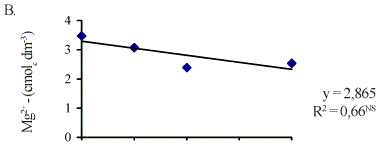The soils degraded by salts and sodium, common in the irrigated areas of the semi-arid region, present physical and chemical attributes unfavorable for the agriculture. The low availability of nutrients, like phosphorus, in these soils is a reality, therefore, employment of amendments and the study of availability of phosphorus in these areas constitute an alternative to reintegrate such soils to the agricultural production. An experiment was installed in a greenhouse to verify the effects of four levels of gypsum (0, 50, 100 and 200% of gypsum requirement) and phosphorus (0, 150, 300 and 450 mg kg-1), in a saline-sodic soil (Cambisol, EC 4.2 dS m-1; ESP 52, pH 6.3 and CaCO3 65 g kg-1) of clay loam texture (sand 18,8%, silt 43,9% and loam 37,3%) of the Irrigated Perimeter of Capoeira - São José do Bonfim - PB. Samples were collected to determine phosphorus availability, Na, Ca, Mg, pH, PST and EC. The analysis of the parameters showed that P availability, Na, Ca, Mg, pH, PST and CE showed that gypsum significantly increased Ca and P of the soil and decreased the pH and ESP. The application of gypsum and phosphorus increased P and decreased Na. For the others variables the effect of the treatments was not significant.
gypsum; phosphorus; salinity; sodicity











